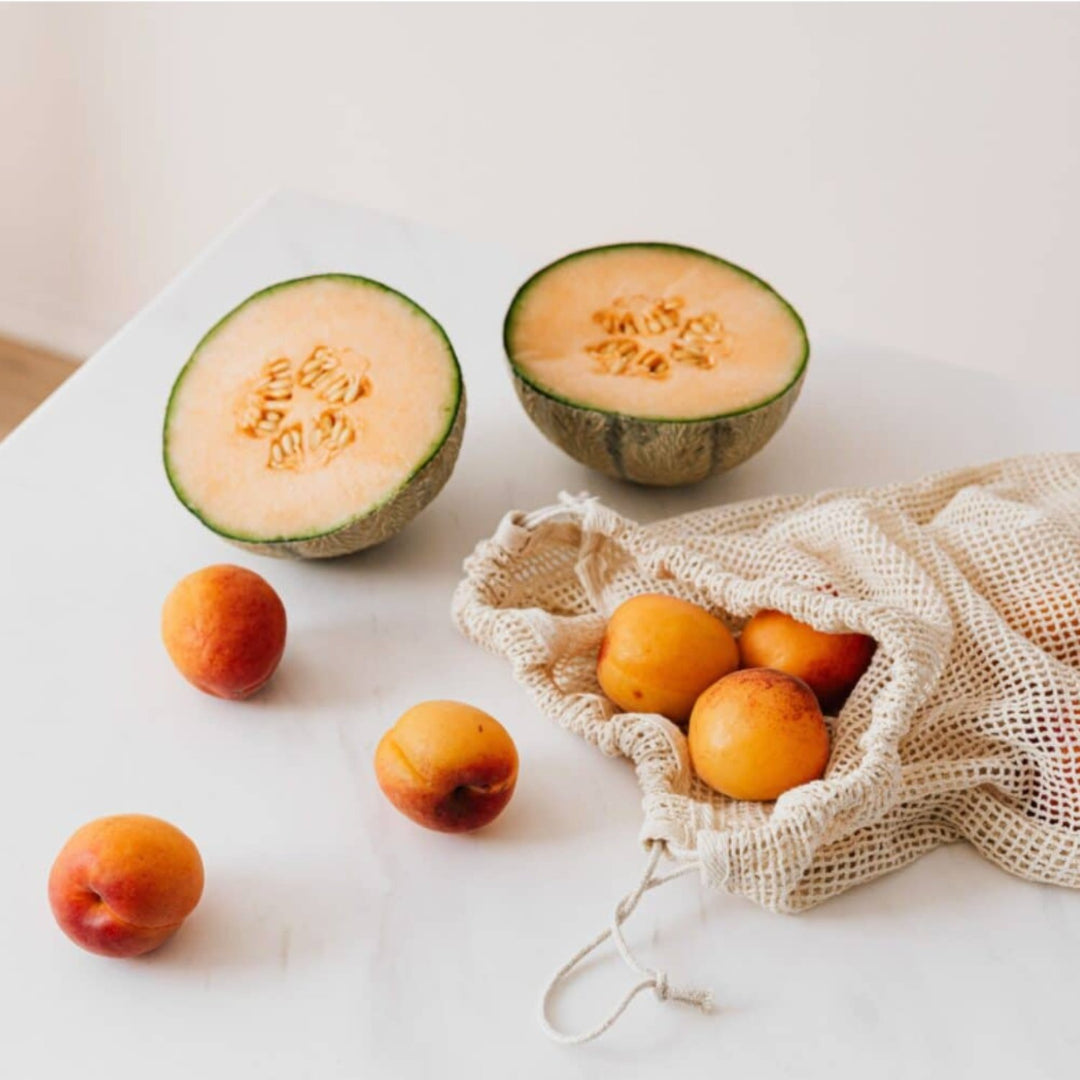A danger looms over the great cycle of life: ocean pollution.
And yet, this great cycle is so well conceived. After rain comes fair weather; after winter, spring, and so on.
Isn't it reassuring to know that happiness will return, that misfortune will pass? In nature, as in the human body, cycles follow one another and look alike.
The human being, essentially made of water...
Ocean cycle.
Menstrual cycle.
The ocean, the cradle of life in general, and the womb, the birthplace of human life, are connected. Their respective health is interdependent.
Today, both are under threat.
In the context of the Semaine de l'Océan, Mme L'Ovary joins forces with the Organisation Bleue to highlight the challenges that plastic pollution of the ocean and the presence of PFASs in the environment, including those contained in menstrual products, represent for the health of natural ecosystems.
We'll be drawing a parallel between the tidal cycle and the menstrual cycle, one that's as spiritual as it is practical, to raise awareness of the challenges facing these two essential natural phenomena.
Finally, we'll highlight how the reproductive health of people with uteruses is affected, and suggest some concrete solutions for changing our habits.
Once we have understood, as a society, that a whole future generation of humans will suffer the consequences of our inaction, we will have no other option than to actively contribute, through our daily choices, to reducing pollution in the oceans.
How are the tidal cycle and the menstrual cycle similar?
If it's always been natural to draw a parallel between the ocean cycle and the menstrual cycle, it's for the following reasons...
They are influenced by the Moon
Science has long demonstrated how ocean tides are influenced by the Moon. The gravitational force exerted by the Moon on the rotating Earth draws masses of water towards it, creating high tides on both sides of the globe.
Although the Moon's influence on menstruation is hypothetical, it's easy to imagine. Their respective cycles are similar in length: around 29.5 days for the Moon and between 27 and 29 days for menstruation.
This coincidence, coupled with the inherent regularity of the two phenomena, has led certain cultures to confer power on the Moon to regulate the menstrual cycle, and to weave a link between women and the ocean into their mythology.
Think of Mama Quilla, Inca goddess of the moon and protector of women, or Tethys, Greek goddess of the seas and rivers that nourish the Earth.
Even Charles Darwin, author of the theory of evolution, believed that the different phases of the lunar cycle were synchronized with those of the menstrual cycle, giving the Moon power over human and animal reproduction.

They comprise different phases
The parallels between the ebb and flow phases of the ocean and the phases of the menstrual cycle are based on natural, regular rhythms that manifest themselves in phases of rise, peak, fall and rest. Here's a look at their symbolism.
Flow and the follicular phase
At rising tide, the flow represents a period of growth and energy accumulation.
Similarly, during the follicular phase, which follows the menstrual period, the ovaries prepare a new egg and the endometrium begins to regenerate, symbolizing preparation and the build-up to ovulation.
High tide and ovulation
At high tide, the peak of the flow, the water is at its highest level; energy is at its peak.
At ovulation, fertility is also at its peak. The ovum released symbolizes the peak of reproductive potential and biological energy.
Reflux and the luteal phase
In the ebb phase, the water begins to diminish in height, quietly preparing for the next tide.
Similarly, in its luteal phase, which follows ovulation, the body prepares either to sustain a pregnancy, or to start the cycle again. It's a symbol of transition and preparation for a new beginning.
Low tide and the menstrual phase
At low tide, the water level is at its lowest. The ocean takes a moment of rest and renewal before the next flood.
Similarly, at the beginning of the menstrual cycle, the uterine lining is expelled with the unfertilized egg, and the uterus is purified and renewed for the next cycle.
Their moods vary and fluctuate
Weather conditions, changing currents, atmospheric pressure, tectonic movements: many factors can affect the mood of the ocean.
Sometimes calm and welcoming, other times tempestuous and unleashed, it's “mood swings” are reminiscent of the different emotional waves a menstruating person goes through over a cycle.

They are in symbiosis with the environment
The ocean and the menstrual cycle are, each in their own way, systems of renewal and purification.
Through natural phenomena such as upwelling and sedimentation, the ocean captures and recycles nutrients. When these functions are altered, the balance and health of all marine ecosystems are affected.
Similarly, when reproductive health is good, the menstrual cycle enables the development of a healthy embryo.
It's easy to figure out why it’s important to stay in harmony with your body, and to respect and honor its biological cycles, just as it's crucial to protect and respect the ocean ecosystem, the ultimate barometer of the health of the globe we inhabit.
What impact does plastic pollution have on the ocean?
Unfortunately, it's hard today to remain insensitive to the accumulating data on plastic pollution of the ocean.
In its 2019 to 2024 Report titled Portrait of Plastic Pollution in Eastern Canada: From the Great Lakes to Newfoundland, the Organisation Bleue reported that "87% of the plastic waste we generate ends up in landfills or in the environment".
Unfortunately, disposable tampon applicators are among the sad top 20 types of plastic waste most frequently collected by their teams during the major clean-ups organized as part of their report.
The consequences of plastic pollution in the ocean on marine fauna and ecosystems are many and far-reaching. Among the most important are :
- ... coral reefs, shorelines and nesting habitats of seabirds and turtles are damaged, creating distress, suffering and even death for the animals that depend on them;
- ... microplastics (plastics less than 5 mm in surface area, often themselves debris from larger pieces of plastic) are ingested by marine animals, including phytoplankton, disrupting the entire food chain, including humans;
- ... the presence of non-decomposable plastic alters decomposition and sedimentation processes, directly impacting natural nutrient cycles.

What about PFAS in water?
But while plastic waste and its accumulations, now known as "plastic oceans", are obvious by their varied shapes and colors, there are other types of pollutants, just as present, but more subtle and more vicious, which are worth investigating. These are PFAS.
What are PFAS and how do they end up in the ocean?
"SPFA" is an acronym that stands for "per- or polyfluoroalkyl substances". These are various chemical compounds (over 4700 known to date) used for their water, oil and heat resistance properties. They are found in a variety of products, including:
- Food packaging such as microwave popcorn bags, pizza boxes and fast-food packaging.
- Textiles and clothing, to make fabrics waterproof and stain-resistant. Examples include outerwear and sportswear, washable menstrual panties, carpets, upholstered furniture and curtains.
- Cleaning and polishing products for the home and the car.
- Pans and other non-stick cookware.
- Cosmetics, including foundations, lipsticks and mascaras, to improve their durability and water resistance.
- Foams used to extinguish fires.
- Electronic devices, to increase their resistance to heat and chemical degradation.
- Various industrial coatings, to protect against chemicals and extreme temperatures.
PFASs, initially appreciated for their unique properties, are now subject to serious environmental and health concerns. It has been demonstrated that these substances do not decompose, hence their nickname of "eternal pollutants".
All the products we use every day are rinsed down our sinks, washed in our washing machines and hosed off, releasing residues into the environment.
These residues, which include PFAS, end up and accumulate as pollution in the oceans, on land and in living organisms, disrupting natural and biological cycles and threatening the health of the entire planet.

The risks of PFAS for women's reproductive health
One of the reasons why PFAS pose a real risk to human health is that they persist in the environment and accumulate within living organisms, giving them a certain toxicity. In other words, PFAS turn all the ecosystems they pollute into dumping grounds.
Health effects are generally associated with prolonged exposure or high levels of PFAS, but even exposures to relatively low concentrations can pose risks.
These include thyroid function disorders such as hypothyroidism, which impact metabolism and general health.
PFASs are also known as endocrine disruptors, because they interfere with the body's natural hormones, impacting the menstrual cycle and reproductive system.
They are associated with an increased risk of developing certain types of cancer, notably kidney and ovarian cancers, leading to fertility problems in people with uteruses.
Prenatal exposure to PFAS is itself a cause for concern, as it can affect fetal development, leading to birth defects and cognitive and behavioral disorders in children.
Some possible solutions
In the light of this information, the urgency of taking action against ocean pollution is clear, and it must be taken on several levels in parallel. What options are open to us as individuals if we want to have a real, tangible impact?
To reduce our impact on ocean pollution
As menstruating people, our action to reduce pollution in the oceans starts with the adoption of more ecological habits in terms of menstrual protection. While respecting our own rhythm, we can choose to :
- ... replace the tampon with a menstrual cup or disc, which cost between $50 and $100 and can last up to 10 years.
- ... replace disposable sanitary towels with washable menstrual pads and period panties (they can be reused for many years).
- ... learn to practice instinctive free bleeding.
There's no need to shake up all your habits at once, or you'll just end up frustrated. For example, you can start by wearing your menstrual panties at the weekend, and stick to disposable pads when you go to work during the week.
Over time, these habits will be modified according to our needs and desires. It's the natural course of life: let it flow, while orienting its direction...
It's even possible to take advantage of refunds offered by over 200 municipalities to date to make your purchase of sustainable menstrual products pay for itself in a fraction of the time, thanks to the #sangdéchet movement launched in 2020 by Mme L'Ovary.
As a small, women-owned company, we are committed to zero waste. This value, central to our mission and operations, has guided our decisions from day one, and we're proud of it.

To reduce your exposure to PFAS
That said, even making conscious choices like switching to washable menstrual pants, with scandals like Thinx and PFAS in 2023, we realize it's not always easy to know exactly what goes into the products we buy.
Our first tip would be to look for products with eco-labels such as GOTS (Global Organic Textile Standard), or OEKO-TEX® STANDARD 100, a guarantee of the health and ecological quality of textiles and leathers.
Also, make sure you buy from companies that are committed to transparency, because they know it's a good selling argument (like us here, who tell you all about our PFAS-free certification).
Of course, this means being curious, looking for information on the websites or blogs of the brands that appeal to us, reading the media articles that test and approve products (enjoy it, they've done the work for us), but our health is worth the effort.
Calling the community to action!
Many countries around the world have already understood the importance of preserving natural cycles and have taken steps to reduce ocean pollution.
In April 2024, the U.S. House of Representatives introduced Bill 8074 titled The Forever Chemical Regulation and Accountability Act of 2024 (or "FCRAA 2024"), which aims to phase out all non-essential uses of PFAS over a 10-year period.
Canada, on the other hand, while considering regulating all PFASs as a class of toxic substances under the Canadian Environmental Protection Act, has to date introduced no such legislation, let alone one specifically targeting menstrual products.
It is therefore driven by a wave of L'Ove for our community, for our sisters, brothers and children, for our oceans and Mother Earth, that we are calling for collective action and launching this petition today.
We demand that the Government of Canada take a serious look at this issue and make the necessary decisions to ban the use of PFAS in menstrual products once and for all.
Let's unite and share in large numbers. Our survival as a species depends on it.
Viva!























